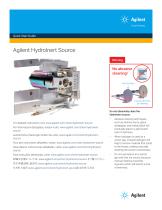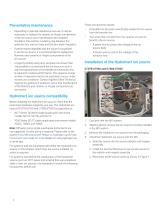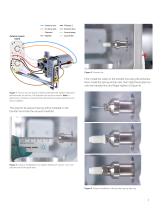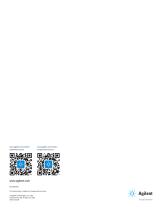
Catalog excerpts

Quick Start Guide Agilent HydroInert Source Warning No abrasive cleaning! Inert surface Losing inertness by cleaning Do not abrasively clean the HydroInert source. – Abrasive cleaning techniques, such as alumina slurry, green sandpaper, and metal polish will eventually lead to a permanent loss of inertness. When hydrogen is used as a carrier gas, ionized hydrogen will help to remove material that sticks to the lenses, making manually cleaning the source unnecessary. Do not use helium as a carrier gas with this ion source, because manual cleaning would be required, which will lead to a loss of inertness. For detailed instructions visit: www.agilent.com/chem/hydroinert-source Per informazioni dettagliate, visitare il sito: www.agilent.com/chem/hydroinertsource Ausführliche Anleitungen finden Sie unter: www.agilent.com/chem/hydroinertsource Pour des instructions détaillées, visitez: www.agilent.com/chem/hydroinert-source Para obtener instrucciones detalladas, visite: www.agilent.com/chem/hydroinertsource Para instruções detalhadas, visite: www.agilent.com/chem/hydroinert-source 詳細な手順については、 www.agilent.com/chem/hydroinert-source をご覧ください。 关于详细说明, 请访问: www.agilent.com/chem/hydro
Open the catalog to page 1
Preventative maintenance – Depending on sample cleanliness and use, it may be necessary to replace the ceramic or Vespel components of the ion source as a maintenance item (repeller insulators, the ceramic insulating ring between the extractor lens and ion body, and the lens stack insulator). If performance degrades and the cause is suspected to be the ion source, it is recommended to replace the filaments and ceramic or Vespel components of the ion source. Longevity testing using dirty samples has shown that it is possible to contaminate the ion source in such a way that replacement of the...
Open the catalog to page 2
Entrance lens Extractor lens Ceramic source board Source heater First, install the collar on the transfer line using the setscrew. Next, install the spring and tip seal, then slide the knurled nut onto the transfer line, and finger-tighten it (Figure 4). Figure 1. The ion source wiring is identical between the Agilent HydroInert and extractor ion source. The extractor ion source is shown. Note: A green wire, not shown, connects from the ceramic source board to the ion source radiator. The ceramic tip seal and spring will be installed on the transfer line inside the vacuum manifold. Figure...
Open the catalog to page 3
www.agilent.com/chem/ hydroinert-source www.agilent.com/chem/ te-hydroinert-source www.agilent.com DE70482935 This information is subject to change without notice. © Agilent Technologies, Inc. 2022 Printed in the USA, October 21, 2022 5994-5315EN
Open the catalog to page 4All ACEA Biosciences Inc. catalogs and technical brochures
-
Agilent Torr Seal Products
3 Pages
-
Agilent TPS-flexy
5 Pages




















